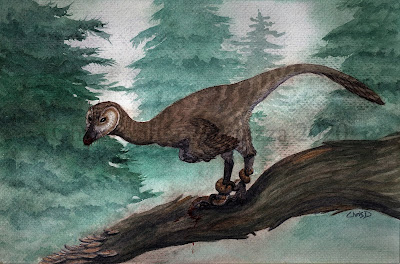 |
| My watercolor life restoration of Pectinodon bakkeri. This animal was likely hunting smaller prey when it was alive, so cretaceous snakes could have been on the menu. |
You may recognize Pectinodon by a different genus name, Troodon. This is because Pectinodon was renamed Troodon during the 1980s. Then in 2011, after further study, it was split back into its own taxa again. In fact, the Troodon genus was split up into multiple taxa based on differences in morphology as well as the fact that all these fossils spanned an extremely long amount of time for only one genus of animal to have been living. The "Troodon" dinosaur that lived during latest Cretaceous in the North American community, called the Hell Creek Formation, was Pectinodon. The original name is still used to describe the family that all these smaller bird-like dinosaurs came from, Troodontidae.
 |
| Photograph of one of Pectinodon's teeth. Note how the anterior has deep serrations. |
Pectinodon was likely covered in feathers when alive and probably would have looked like a bird to most of us at first glance if we encountered it today. Its legs were probably long and slender, which would have allowed it to have run swiftly if it needed to. This was probably a helpful trait since it would have been pursuing prey as well as avoiding potential predators, like the similarly sized, but more heavily armed, Acheroraptor, and even Tyrannosaurus rex (which was much faster and more agile as a subadult) Being most active at night is also another way to avoid predation and is a tactic used by many animals today.
References
Currie, P. (1987). "Theropods of the Judith River Formation". Occasional Paper of the Tyrrell Museum of Palaeontology 3: 52–60.
Holtz, Thomas R., Brinkman, Daniel L., Chandler, Chistine L. (1998) Denticle Morphometrics and a Possibly Omnivorous Feeding Habit for the Theropod Dinosaur Troodon. Gaia number 15. December 1998. pp. 159-166.
Larsson, H.C.E. 2001. Endocranial anatomy of Carcharodontosaurus saharicus (Theropoda: Allosauroidea) and its implications for theropod brain evolution. pp. 19-33. In: Mesozioc Vertebrate Life. Ed.s Tanke, D. H., Carpenter, K., Skrepnick, M. W. Indiana University Press.






